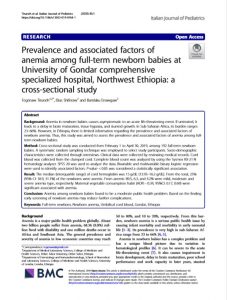
Background
Anemia in newborn babies causes asymptomatic to an acute life-threatening event. If untreated, it leads to a delay in brain maturation, tissue hypoxia, and stunted growth. In Sub-Saharan Africa, its burden ranges 23–66%. However, in Ethiopia, there is limited information regarding the prevalence and associated factors of newborn anemia. Thus, this study was aimed to assess the prevalence and associated factors of anemia among full-term newborn babies.
Method
Cross-sectional study was conducted from February 1 to April 30, 2019, among 192 full-term newborn babies. A systematic random sampling technique was employed to select study participants. Socio-demographic characteristics were collected through interviews. Clinical data were collected by reviewing medical records. Cord blood was collected from the clumped cord. Complete blood count was analyzed by using the Sysmex KX-21 N hematology analyzer. SPSS 20 was used to analyze the data. Bivariable and multivariable binary logistic regression were used to identify associated factors. P-value < 0.05 was considered a statistically significant association.
Result
The median (interquartile range) of cord hemoglobin was 15 g/dL (13.93–16.2 g/dL). From the total, 25% (95% CI: 18.9, 31.1%) of the newborns were anemic. From anemic 89.5, 6.3, and 4.2% were mild, moderate and severe anemia type, respectively. Maternal vegetable consumption habit (AOR = 0.34, 95%CI: 0.17, 0.69) were significant associated with anemia.
Conclusion
Anemia among newborn babies found to be a moderate public health problem. Based on the finding early screening of newborn anemia may reduce further complications.